November 10 – December 19, 2008
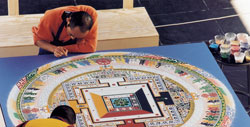
A fascinating look at the creation and profound inner meaning of the Buddhist mandala, an intricate and vividly colored pattern that represents an enlightened universe. 60 minutes.
November 6 – May 23, 2008

Between 1550 and 1650, Italian artists and the city of Rome were at the center of the European art world and, despite the rise of Paris and London in the eighteenth century, Rome remained the most important cultural center until about 1800. Rome was, above all, the source of the western European classical tradition, visibly manifested by the Roman architectural and sculptural monuments dominating the city. And there was the Italian landscape, especially the Roman Campagna, the lands stretching south and east of the city. The landscape and light of the Campagna inspired artists until the end of the nineteenth century. The city’s warm climate, its exotic fruit trees, and its centuries-old history attracted Dutch, Flemish, French and German artists from the seventeenth century on, for no artist could avoid the weight of the classical tradition nor the landscape that Rome and Italy embodied.
November 4 – November 9, 2008
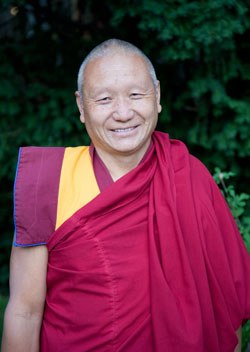
It’s been five years since we’ve had visiting monks at the Benton! From November 4th through 9th, two monks from Namgyal Monastery, Thupten Woser and Lobsang Tashi, will be in residence at the Benton tocreate a Sand Mandala of Enlightenment in the East Gallery. During this time, the public is invited to attend the monks’ morning prayers and meditation at 9 a.m. Tuesday through Friday.On November 5, at 12:15, former Benton Museum Director Salvatore Scalora will give a gallery talk about “The Making of a Mandala” while the monks work.Mandalas are intricate creations made by applying many different colored sands, grain by grain, to a particular design. They date back to the 6th century B.C.E. when, according to Buddhist tradition, the purpose, meanings, and techniques were taught by the Buddha Shakyamuni.
Once completed, the Mandala of Enlightenment will remain on view until Sunday, December 7, at 2 pm when, in a sacred, prayerful ceremony, the monks will sweep the colorful sands into an urn and disperse them into the waters of Mirror Lake. The dismantling of a mandala is regarded as a blessing on the area and a reflection of the impermanence of all things. Those attending the ceremony will receive a small packet of the sand for good health and healing.
October 21 – December 19, 2008

This exhibition features fabric art pieces from the collections of Peter Polomski and Richard Allen. Historically, the majority of Tibet’s greatest art has been bound up with religion, and the most prominent traditions include tangkas, or scroll paintings of Buddhist and Bon divinities. Since very few Tibetans learned to read and write, tangkas have served as a pictorial lesson that the observer could remember through painted icons rather than printed script. Tangkas further provide an opportunity for meditation; by seeing and concentrating on the figures painted on the tangka, the practitioner strives for liberation or enlightenment through the act of beholding.
To complement and create a context for the tangkas and the sand mandala, several dramatic photographs of the Himalayan Mountains by Kenneth Hanson will hang in the East Gallery. They are images from his acclaimed book, Himalayan Portfolios: Journeys of the Imagination.
September 2 – October 12, 2008
Painting, sculpture, illustration, graphic design, printmaking, photography and installation art will all share the East Gallery in this autumn’s 43rd annual Art Department exhibition. Much has changed in the art world since the first exhibition in 1967, but the technical excellence, the modernity and the artistic quality of this exhibition remain consistently engaging. The faculty works represent the diversity of themes and styles of the modern art world while highlighting the singularity of each of their visions. This year’s featured artists, both of whom work on a large scale, are Professors Deborah (Muirhead) Dancy and Ray DiCapua.

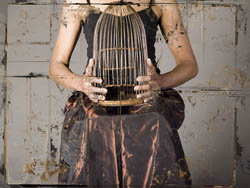
August 26 – December 19, 2008

Sheila Rock’s Sera: The Way of the Tibetan Monk is only occasionally a photographic document of the daily life of the Tibetan monks of the Sera Monastery in Bylakuppe in Southern India’s Mysore district. Rather, it is an extended visual essay on a state of mind; portraits of a group of individuals, many of them teenagers and children as well as elderly, who share a common social and philosophical framework in Tibetan Buddhism.In 1998, when Sheila Rock, an established fashion and portrait photographer, first encountered the monks and life in the Sera Monastery, she was struck by the quietude and serenity of the place and the individuals. The following year, with the permission of the abbot, she returned and began photographing the monks and novices individually and in groups. Perhaps from her background in fashion photography, she frequently used a plain backdrop for the many portraits of one or two individuals. This had the effect of removing the figure from the context of
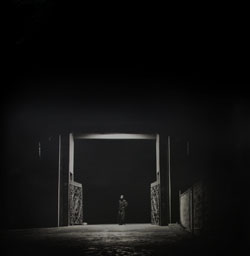
the monastery and focusing intensely on the subject himself. Many of these portrait studies appear to reveal the individual’s inner personality, yet because of the language barrier, she “felt that [she] was working completely visually.” Clearly, it is her intuitive visual aesthetic that coaxes from these portraits the mind of the individual portrayed and the compelling beauty of the imagery.
She also has taken photographs of the monks in their rooms, at work, at prayer, at play, or ceremonially gathered. These photographs, with their discursive subjects and more complex backgrounds, are artistically different from the individual portraits. However, they share one quality that is expressive of the personality of the monks individually and as a group. They have within them a mutual joy for the company of one another and for the life that has been chosen for them. If the serenity of the individual is only implied in the larger numbers of these images, the satisfaction of the monks with the life of the Buddhist monastery is complete. Sheila Rock’s images speak clearly of a Buddhist adherence to a life of meditation and learning, and the quest to overcome strife, anxiety, and venality in our human sphere. Artistically, she has created a body of works that are the loveliest of pictures.
June 3 – August 10, 2008
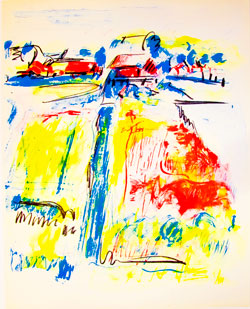
Although lithography after World War II was generally considered a commercial medium, between 1958 and 1960 three new lithographic workshops opened that sought to re-create lithography as an artistic medium. In 1958 ULAE on Long Island, Collectors Graphics in New York city in late 1959, and Tamarind in 1960 in Los Angeles. Of the three, Collectors Graphics had the briefest run, only until early 1963, but an interesting technical history and in its roster a cross section of well-known and, today, lesser-known artists of the period.
In 1959, the painter Reginald Pollack (1924-2001) met Jules Sherman the owner of a commercial lithographic firm in Manhattan. Pollack had studied lithography in Paris after the war and, when he returned to New York city in the late 1950s, his interest in medium continued, and he found a sympathetic partner in Sherman. Their idea was to provide artists with the means to create original lithographic prints with no photomechanical aides, to publish them in limited editions at low cost to the collector, and to do so without the artist having to use heavy and cumbersome lithographic stones. Sherman’s commercial workshop would be available on weekends to provide the tools and means for artists to make lithographic prints.
The greatest difficulty they faced was finding a suitable substitute for the lithographic stone. There were many failures until the solution came to Sherman in the middle of the night: Use a flexible, plastic impregnated paper that was commercially available although usable only for short runs. Initially the sheets were too small, however, once Sherman had a supply of larger sheets, he could give the artists a matrix on which they could draw using any suitable crayon or ink and from which he could print the image. The completed lithographs were printed very slowly on an offset press, and despite a planned editions of seventy-five to one hundred impressions, the plates frequently failed and the run ended after only fifty to sixty finished examples.
According to Jules Sherman, Collectors Graphics was never a commercial venture, and the driving force that held it together artistically was Pollack. When Pollack left New York city for Virginia in 1963, the artistic impetus was gone and the workshop closed its doors in that year.
This exhibition, drawn from a larger gift of eighty-five lithographs, highlights the accomplishment of these artists who ventured into new artistic territory. The brief history of Collectors Graphics is the sum of these works, and a history worth recording. The artists are interesting, the works they did are of high quality, and Collectors Graphics is a part of the history of the rediscovery of lithography in America as an artistic medium for the creation of original works of art.
April 12 – May 11, 2008
After two years of intense studio research, five dynamic young MFA candidates will exhibit their work at the William Benton Museum of Art from April 12-May 11. Pentameter showcases the diverse talents of Valerie Garlick, Matt Jensen, Patrick Earl Hammie, Jenn Dierdorf, and Krysten Bailey.

Valerie Garlick’s video work mixes elements of open source media, chroma key compositing, vintage pop music and performance. Her photography conceptually materializes residue from online social networks and technology based presentation management.

Patrick Earl Hammie’s larger-than-life paintings explore the tension between power and vulnerability as he re-imagines the modern male and questions traditional example of masculinity. His work draws upon his life history as a son, a male, and an African American struggling to synthesize past adversity and acclimatize to present realities.

Dierdorf’s drawings and prints utilize repetitive actions that map, chart, trace and scribble. Her final works create infinite possibility and become records of the learning and transformation she experienced.
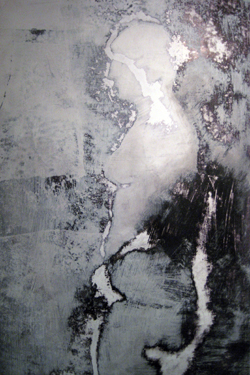
Krysten Bailey’s prints explore the human body, its growth, transformation, deterioration and decay. The work considers physical and psychological complexities surrounding body and self-perception through a combination of figurative imagery, process, texture, and atmosphere.
March 19-May 11, 2008
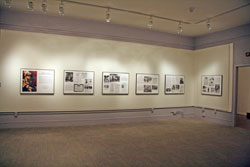 Marcus Garvey: The Centennial Exhibition, a sampling of the rich photographic legacy left by America’s most colorful black nationalist, is on exhibition at The William Benton Museum of Art through May 11. Originally mounted in 1987 in commemoration of Garvey’s 100th birthday, the exhibition is touring nationally under the auspices of the Schomburg Center’s Traveling Exhibition Program.
Marcus Garvey: The Centennial Exhibition, a sampling of the rich photographic legacy left by America’s most colorful black nationalist, is on exhibition at The William Benton Museum of Art through May 11. Originally mounted in 1987 in commemoration of Garvey’s 100th birthday, the exhibition is touring nationally under the auspices of the Schomburg Center’s Traveling Exhibition Program.
The exhibition is organized by the Schomburg Center for Research in Black Culture, The New York Public Library and is sponsored by the William Benton Museum of Art in collaboration with the Institute for African American Studies and is presented in conjunction with the Institute’s conference, “The Harlem Renaissance Revisited: Politics, Arts & Letters,” which will be held on the University of Connecticut campus March 27-29, 2008.
The growth of Garvey’s militant Universal Negro Improvement Association (UNIA) is said to be one of the most photographed social movements of the 20th century. The cream of that collection has been assembled for this exhibition. This display, drawn from the bountiful Garvey archives in the Schomburg Center and the UNIA Papers Project of the University of California, Los Angeles, also includes dozens of historical documents, prints and publications. Together they retell the rise-and-fall tale of Garvey’s humble beginning, his ascension to prominence, his comeuppance, and his indelible influence on the course of African-American history.
“The messages conveyed by this exhibit offer new opportunities to increase our understanding and appreciation of the Garvey movement,” said Howard Dodson, Chief of the Schomburg Center.
Garvey’s movement in its 1920s heyday — and even to the present — was extremely controversial and widely misunderstood. A spellbinding orator, Garvey used his public speaking skills to build in this country the first mass movement with a black nationalist agenda. The association founded the Negro World, which with French and Spanish sections quickly became one of New York’s leading weeklies. The group promulgated new standards, strangely new to some, of racial cohesion, internationalism and pride.
UNIA sought to create economic opportunities for its followers. It purchased property and established a shipping line. Wanting to provide capital and technical help to black-owned businesses, UNIA created its own finance company, the Negro Factories Corporation — a private sector precursor of sorts to the federal Small Business Administration.
The authorities reacted with alarm to Garvey’s rising popularity and in time officially accused him of financial misdealings. As a result of the ensuing legal entanglements, UNIA’s empire subsequently fell apart. But, today both Garvey and UNIA have been vindicated. The nationalist precepts which Garvey preached are now gospel to legions.
Marcus Mosiah Moses was born in St. Ann’s Bay, Jamaica in August 1887, the youngest of 11 children. He came inconspicuously to the United States twenty-nine years later, traveling around the country for a year before settling in Harlem in 1917. Three years later he presided over the first international convention of his fledgling UNIA. During much of the following decade he enjoyed one triumph after another, earning for himself the nickname of “the Black Moses.” But he was deported in 1927, three years after a controversial conviction for mail fraud. Garvey died in London in 1940, some twenty years before his ideas began to flourish once again.
The Schomburg Center Traveling Exhibition Program is designed to offer graphic interpretations of black history and culture to institutions and organizations in communities throughout the United States. Mr. Dodson explained that “We have produced the traveling exhibitions not only for the enjoyment they may bring to many new viewers across the country, but more importantly, to encourage the study and creative assessment of the subject areas by scholars, students and the general public alike.”
This exhibition is sponsored by the Institute for African American Studies and is presented in conjunction with the 2008 conference, The Harlem Renaissance Revisited.
January 22 – March 30, 2008
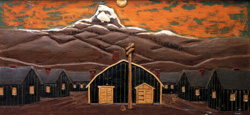
In Japanese, the word gaman means, “enduring the seemingly unbearable with patience and dignity.” This exhibition is based upon a ground-breaking book (The Art of Gaman, Ten Speed Press, 2005) by Delphine Hirasuna, who is the exhibition’s guest curator. It presents arts and crafts made by Japanese and Japanese Americans who were interned in concentration camps in California, Wyoming, Arizona, Utah, Idaho, Colorado, and Arkansas during World War II. The exhibition features nearly 200 objects made primarily from scrap and found materials by those detained in the camps and gives a sense of the full range of artistic activities that existed within the internment camps that saw the forced relocation of 120,000 Japanese and Japanese Americans. The exhibition also demonstrates the resiliency of the creative spirit—how human beings are able to create objects of beauty and meaning with humble materials and under the most difficult circumstances.
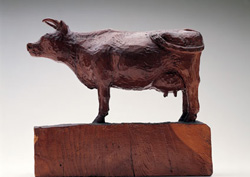
This exhibition is based upon the book The Art of Gaman: Arts and Crafts from the Japanese American Internment Camps 1942-1946 by Delphine Hirasuna (Ten Speed Press, 2005) and was first held at the San Francisco Museum of Craft and Folk Art. The touring exhibition has been organized by the William Benton Museum of Art, University of Connecticut, and the Oregon Historical Society in collaboration with the National Japanese American Historical Society. The Benton presentation is made possible with the support of the Connecticut Commission on Culture and Tourism and the Nathan Hale Inn and Conference Center, and in partnership with the University of Connecticut Asian American Cultural Center, Asian American Studies Institute, and the Foundations of Humanitarianism program.